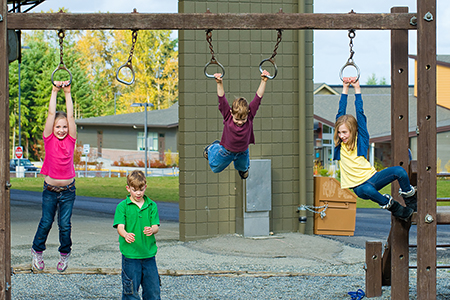Although research has documented a link between physical activity and classroom success, many elementary school children do not have opportunities to engage in physical activity during a typical school day. Playworks aims to create a place for students on the playground to feel included, be active, and build social and emotional skills by placing full-time coaches in low-income schools to organize and oversee recess. The program’s goals are to engage students in physical activity, foster social skills, improve ability to focus on class work, decrease behavioral problems, and improve school climate.
Mathematica recently conducted the first rigorous evaluation of the Playworks program, and four academic journals have now published some of the results. The highlights and important findings from each journal article follow.
“The Impact of Playworks on Students’ Physical Activity During Recess: Findings from a Randomized Controlled Trial.” Preventive Medicine
This article reports on the impact that Playworks had on students’ physical activity during recess. The authors evaluated the impact of Playworks on measures of the intensity of students’ physical activity, number of steps taken, and percentage of time spent engaged in vigorous activity. The authors found significant impacts on some outcome measures, but not others. Teachers in Playworks schools reported that students were more active during recess, but accelerometer and student survey measures showed either no impacts or marginally significant impacts.
“Estimated Distributions of Usual Physical Activity During Recess.” Medicine and Science in Sports and Exercise
The first to examine specific distributions of usual physical activity in school-age children, this article makes an important contribution to the fields of sports medicine and exercise science. Focusing on the use of measurement error models to analyze the data, the authors found considerable intra-individual variability when measuring the distributions of students' physical activity. Without properly identifying and adjusting for intra-individual variability and other forms of measurement error in the data, physical activity estimates might be considerably biased.
“The Impact of Playworks on Boys’ and Girls’ Physical Activity During Recess.” Journal of School Health
This article examines the effectiveness of the Playworks program on boys and girls. Research has traditionally shown that boys have higher levels of moderate-to-vigorous physical activity during recess than girls. The authors found that Playworks had a positive impact on girls’ physical activity (in terms of accelerometer intensity counts, time spent in vigorous physical activity, and the extent to which girls were sedentary). No significant differences based on accelerometer data were found for boys. This article shows show that the Playworks program holds promise for increasing girls’ physical activity.
“The Impact of Playworks on Students’ Physical Activity by Race/Ethnicity: Findings from a Randomized Controlled Trial.” Journal of Physical Activity and Health
In this article, the impact of Playworks on students by race and ethnicity was examined. The authors found that Playworks significantly increased physical activity for black students (and to a lesser degree Hispanic students). Minority students in non-Playworks schools typically engaged in less physical activity, suggesting that Playworks might be a promising strategy for increasing the physical activity levels of minority students.


